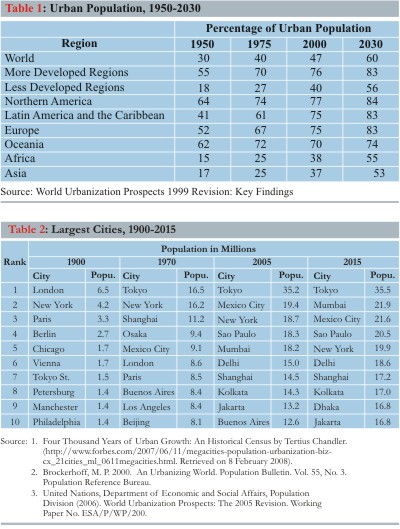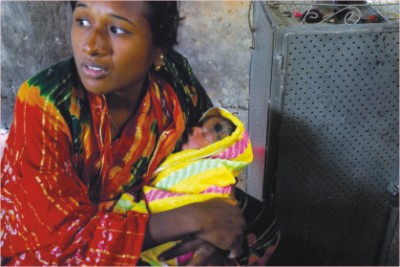
Inside
|
Unstoppable Urbanisation Md. Masud Parves Rana explores the issues behind the world's largest cities Not even wars, natural disasters, or public policies have slowed the pace of urbanisation. During the late 19th century, rapid growth of population occurred in industrial countries -- the urban revolution. The same revolution is now taking place in the developing countries, expanding technological opportunities on one hand, and damaging sustainability and livability on the other.
The people are concentrated in and around major cities of the world. It is estimated that 90% of urban population growth will be in less developed continents, i.e. in Asia, Africa and Latin America. It is also estimated that by 2015, more than half of the population of the developing world will live in cities, and 80% of the world's largest cities will be in this region. World urban population The UN forecasts today's urban population of 3.2 billion will rise to nearly 5 billion by 2030, when three out of five will live in cities. The increase will be most dramatic in the poorest and least-urbanised continents -- Asia and Africa. Surveys and projections indicate that all urban growth over the next 25 years will take place in developing countries. Table 1 (see following page) shows the percentage increase of urban population in the world from 1950 to 2030. It is projected that in 2030, 60% of the population will be living in urban areas of the world, double the figure in 1950. More developed countries show a saturation in urbanisation, but less developed countries' urban populations would have more than tripled from 1950 to 2030, rising from 18% to 56%. Asia and Africa will face tremendous urban pressure in the next few decades, and in 2030 urban population will be just over 50%. Particularly, the big cities will be in trouble due to ever-increasing population and growing numbers of urban poor. Urban population in megacities There were 83 cities or city systems with populations of more than 1 million in 1950, 34 of them in developing countries. In 2000, there were 280 such cities, and this number is expected to double by 2015. 12 of the world's 15 largest cities are in developing countries. If cities of 8 million are considered, 28 existed in 2000, with 22 of them in developing countries. In 1950, only the largest city in the world, New York, had more than 10 million people, and it is estimated that by 2015, 12 cities will have a population of more than 15 million each. Table 2 depicts the major contribution of Asian cities towards increasing in the world urban population and, for the first time, Dhaka will be included in the list of the ten most populated cities in the world. According to UN's (Department of Economic and Social Affairs, Population Division, 2006) calculation and projection, seven cities in Asia will be included in the list of the highest populated cities in the world. The corresponding figure was six in 2005, four in 1970, and only one in 1900. Mumbai, Sao Paulo, Shanghai, Jakarta and Dhaka are growing very fast, and they are expected to have similar populations very soon. Lagos is the fastest growing city in Africa, with a population of 15 million now. The Nigerian government estimates this city will have 25 million residents by 2015. Moreover, by 2025, according to the Far Eastern Economic Review, Asia alone will have at least 10 hypercities, those with 20 million people or more, including Jakarta (24.9 million), Dhaka (25 million), Karachi (26.5 million), Shanghai (27 million), and Mumbai (with a staggering 33 million) (Davies 2004). Urbanisation and challenges But the reckless, rapacious, and uncontrolled growth of cities and their populations often causes unmanageable situations, which have been a big challenge to almost all the city authorities in the world, particularly in the developing countries. The challenges include rapid urbanisation, rural-urban migration, good governance, poverty, violence, malnutrition and diseases, infrastructure and services, and environmental problems. Rapid urbanisation For instance, in developing countries with 60-70% of the population in rural areas, more than half of the economy -- and often more than that -- is generated in urban areas. Ironically, in most developing countries, urban populations have expanded without associated expansions in the services and facilities essential for a healthy urban environment. The problems are becoming unsustainable and serious because of rapid expansion in urban population with little or no consideration for the environmental implications. Alberti and Susskind (1996) wrote: "Urbanisation occurs so rapidly in developing countries that it typically overburdens the ability of local governments to provide adequate housing, infrasturcture, and other essential services." The nature of urbanisation is an important factor that should be considered in development planning. Poverty and violence That is why poverty is the root cause of the unstable conditions of the cities, which gear up malnutrition and food insecurity, resulting in thousands of people becoming involved in unsocial activities and violence. In addition to the externally identifiable impacts of lack of access to water, sanitation, and health services (pneumonia, malaria, diarrhea, tuberculosis, HIV/Aids), a lack of services also perpetuates poverty. The urban poor spend a higher percentage of their income on treaing illness, and are more likely to lose wages and have less job security when they are forced to miss work -- all of which erodes their coping capacity, and can keep potentially mobile families trapped within a cycle of poverty. Poverty has long been considered a key driver of violent crime too. A World Bank study on violence in Latin American urban areas showed that homicide rates ranged from 6.4 per year per 100,000 in Buenos Aires to 248 in Medellin, Colombia. Rio de Janeiro, Sao Paulo, Mexico City, Lima, and Caracas account for more than half their countries' homicides. More difficult than measuring crime within urban areas has been differentiating between underlying structural causes (like unequal power relations), and trigger risk factors (such as alcohol and drug abuse), which can often precipitate gender-based violence. The danger in mapping and measuring urban violence is that perceptions of violence are then reinforced; because, statistically-speaking, urban centres (especially slums) are subject to more crime, violence can become institutionalised, and more dangerously, a stereotype of slum dwellers as criminals is perpetuated.
One billion people, about one-sixth of the world's population, now live in shanty towns, which are seen as "breeding grounds" for social problems such as crime, drug addiction, alcoholism, poverty, and unemployment. Infrastructure and services Already over 90% of the urban population of Ethiopia, Malawi, and Uganda, three of the world's most rural countries, live in slums. In 2001, 924 million people, or about 31% of the world's urban population, were living in informal settlements or slums, 90% of which were located in the developing world. By 2030, the number of worldwide slum dwellers is projected to reach two billion. In Dhaka, 3.4 million of the city's 13 million residents live in 5,000 slums and squatter settlements. Moreover, 60% of Nairobi's dwellers are packed into more than 130 informal settlements occupying only 5% of the city's total land area, while the squatter settlements of Mumbai are growing 11 times faster than the city itself. As the UN's 2006-2007 State of the World's Cities Report notes: in Ethiopia, child malnutrition in slums and rural areas is 47% and 49% respectively, compared with 27% in non-slum urban areas; in Niger, child malnutrition in slums and rural areas is 50% and 52%, against 35% in non-slum urban areas; and in the slums of Khartoum, the prevalence of diarrhea among children is 40%, compared with 29% in rural areas. As urban populations increase, the number of people without access to clean water is also rising, doubling from 108 million in 1990 to 215 million by 2010. In dense city areas, and even more so in denser slum environments, communicable diseases can quickly become epidemics, making the consequences of unsafe water and poor sanitation much more severe than in rural areas. In Delhi, for instance, scarcity of water is a problem as slum dwellers fight each other to gain access to the one working standpipe in their area, and often go without water for days at a time. Environmental problems For example, 12% of the deaths in Jakarta are related to air pollution causes. Traffic-generated pollutants such as particulates, nitrogen oxide, and carbon dioxide are increasing in cities. In Los Angeles, sulfur dioxide and lead have been significanltly reduced, but particulate matter, carbon monooxide and ozone are still a significant problem. Urban transportation in the developed and developing world is expected to grow, and this will make the situation worse. This is becoming more and more challenging to urban policy makers. There are hundreds of developing cities with high concentrations of industries and significant industrial output. These cities suffer industrial problems comparable to those in Europe, Japan, and North America. In many cities, environmental problems are far more serious.
Pollution and wastes are increasingly trans-boundary problems, and have, in some cases, upset or are upsetting global environmental balances, and pose major threats to the development or even survival of human-kind. The environmental problems are particularly serious in developing world cities because industries are situated in one or two cities of a country. For instance, Dhaka, Mexico City, and Sao Paulo have a high proportion of their nation's industries. Industrial pollution is not the only cause of air and water pollution. The high amount of household and commercial pollutants not served by sewers, drains, and garbage collection also add greatly to land and water pollution problems, while very congested traffic and insufficient and poorly maintained engines in most road vehicles add greatly to air pollution. The quality of water is also questionable, and water borne diseases are quite endemic. In most of the cities, chemical, toxic or hazardous pollutants include lead, mercury, cadmium, chromium, oxides of nitrogen and sulfur, carbon monoxide, petroleum hydrocarbons, suspended particulates, nitrates, cyanide and arsenic. In the developing world, most toxic or otherwise hazardous wastes are either disposed of as liquid wastes which run untreated into sewers or drains or direct into rivers, steams, lakes or other nearby water bodies, or are placed on land sites with few safeguards to protect those living nearby or nearby water sources from contamination. Very few nations have effective government systems to control the disposal of hazardous wastes; in most there are no regulations dealing specially with such wastes, let alone a system to implement them. Such systems need a competent, well-staffed regulatory authority with the ability to make regular checks and the power to penalise offenders. The Kulu River, which runs through two of Mumbai's industrial suburbs, receives the liquid effluents of over 150 industrial units, and these include heavy metal; this produces dangerously high levels of mercury and lead in the water and could cause slow poisoning as heavy metals enter the food chain through cattle grazing on river bank vegetation. Water-related diseases such as typhoid, diarrhea, and cholera increase in frequency downstream of all the rivers across the metropolitan area of Jakarta. The seawater and sediment in Jakarta Bay are clearly affected by the pollution load carried by the rivers discharging into them. Therefore, the major challenge for modern cities is economic, social, and ecological sustainability in the medium and long-term future. Economies of scale may erode the quality of the urban living environment and the social stability of the cities, so a well-tuned effort has to be made to reconcile environmental demands with economic goals of the city. In the present context of urban demographic changes, the quest for sustainability is a big issue, which demands much attention of the stakeholders. Sustainability will not be easy to achieve, particularly for the developing countries.
Urban areas of less developed countries (like Dhaka) will face almost all of the world's population growth, and will contain increasing numbers of poor people. So, the overwhelming growth of population in third world countries will definitely be a matter of future prosperity and sustainability of the world. Md. Masud Parves Rana is PhD Candidate, Department of Geography, National University of Singapore, and Assistant Professor, Rajshahi University. Email: mmprana@yahoo.com. |



